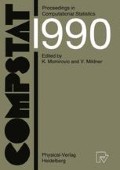Abstract
An automated method designed to handle outliers, missing observations and structural changes in smoothing time series is presented. Smoothing of trend, adjusted for seasonality is done using Akaike’s Information Criterion (AIC) in the L1 (least absolute deviation) context. AIC selects approximations to trend among polynomials of up to degree three or cubic cardinal B-splines with a varying number of knots. A short time series is analyzed to demonstrate the method.
Access this chapter
Tax calculation will be finalised at checkout
Purchases are for personal use only
Preview
Unable to display preview. Download preview PDF.
References
Akaike, H. (1973), “Information theory and an extension of maximum likelihood principle” In 2nd International Symposium on Information Theory (B. N. Petrov and F. Csaki, eds.), 267–281. Budapest: Akademia Kiadd.
Atilgan, T. (1988), “Basis Selection for Density Estimation and Regression,” submitted for publication.
Becker, R. A., Chambers, J. M, and Wilks, A. R. (1988), “The New S Language A Programming Environment for Data Analysis and Graphics,” Wadworth and Brook/Cole Computer Science Series: Pacific Grove, California.
Cleveland, W. S. and Terpenning, I. J. (1982a), “Graphical Methods for Seasonal Adjustment,” Journal of the American Statistical Association 77, 52–62.
Cleveland, W. S., Devlin, S. J., and Terpenning, I. J. (1982b), “The SABL Seasonal and Calendar Adjustment Procedures,” Time Series Analysis: Theory and Practice 1, edited by D. D. Anderson, North-Holland, Amsterdam, 539–564.
Hampel, F. R., Ronchetti, E. M., Rousseeuw, P. J.,and Stahel, W. A. (1986), “Robust Statistics: The Approach Based on Influence Functions,” John Wiley and Sons: New York.
Rousseeuw, P. J., and Leroy, A. M. (1987), “Robust Regression and Outlier Detection,” John Wiley and Sons: New York.
Author information
Authors and Affiliations
Editor information
Editors and Affiliations
Rights and permissions
Copyright information
© 1990 Physica-Verlag Heidelberg
About this paper
Cite this paper
Atilgan, T. (1990). An Automated Method for Trend Analysis. In: Momirović, K., Mildner, V. (eds) Compstat. Physica-Verlag HD. https://doi.org/10.1007/978-3-642-50096-1_41
Download citation
DOI: https://doi.org/10.1007/978-3-642-50096-1_41
Publisher Name: Physica-Verlag HD
Print ISBN: 978-3-7908-0475-1
Online ISBN: 978-3-642-50096-1
eBook Packages: Springer Book Archive

